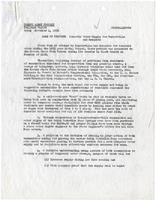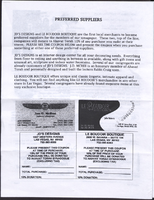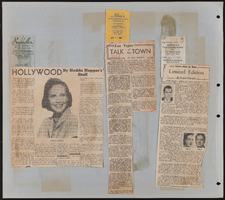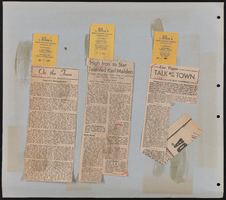Search the Special Collections and Archives Portal
Search Results

Transcript of interview with Jim Olson by Stefani Evans and Claytee D. White, February 2, 2017
Date
Archival Collection
Description
As Las Vegas native Jim Olson looks back on his law career, he keeps returning to the case that gouged a sooty scar on his memory, altered legal practice and technology in Southern Nevada, captured the world's imagination, and changed international building codes-the MGM Grand Hotel and Casino fire of November 21, 1980, that killed 85 people and took eight years to litigate. Olson became involved with the litigation because his firm, Cromer, Barker, and Michaelson, represented the MGM Grand's insurance company, INA, Insurance Company of North America. Juggling thousands of claims, Olson ended up working with the MGM's corporate counsel in Los Angeles, a legal firm in Denver, Lloyd's of London, and a special master; renting additional office space for taking depositions; hiring graveyard-shift transcribers, and purchasing the legal world's latest technological marvel-a fax machine. As a first grader, five-year-old Jim was known to walk home during the school day whenever the St. Joseph nuns scared him. As an attorney whose career path was inspired by Perry Mason and augmented by his argumentative streak, Jim offers insights into litigation about some of Southern Nevada's most iconic buildings, signs, and spaces. In this interview, he recalls his mentors, Al Gunderson, George Cromer, Bill Barker, and Kent Michaelson. He talks of construction defect cases including his first MGM Grand litigation, in which his firm represented the architect, Martin Stern, when faulty siding fell off the building, and the 1994 lawsuits that followed when the top of the newly constructed, 365-foot Las Vegas Hilton sign blew down in a windstorm. He shares tales of legendary fellow attorney Mike Hines and his annual Nevada Bar Association parties on the Mike Hines Ranch, and he speaks to litigation between Hank Greenspun, Howard Hughes, and Hughes Tool Company.
Text

County agent project progress report, Domestic water supply for Bunkerville and Mesquite, November 1, 1936
Date
Archival Collection
Description
Having been unsuccessful in obtaining reliable domestic water, Bunkerville and Mesquite were beginning an all-out lobbying campaign on various agencies for help.
Text
Cliff Segerblom Artwork
Identifier
Abstract
The Cliff Segerblom Artwork contains four pieces of Segerblom's artwork. One painting of a desert home in Nelson, Nevada titled "Afternoon in Nelson" from 1940, one drawing of the USS Hornet from 1969, and two watercolor paintings of Lake Mead and Sunrise Mountain. The First Annual Southern Nevada Art Exhibit originally displayed "Afternoon in Nelson" in Las Vegas, Nevada between January 27 and 28 in 1940. The USS Hornet drawing was created November 1969, depicting a fighter aircraft aboard the USS Hornet at Apollo 12's splashdown. The two watercolors were donated to the University in 1962 by the Clark County Panhellenic Association.
Archival Collection
John S. Wright Faculty Papers
Identifier
Abstract
The John S. Wright Faculty Papers (1951-1975) are comprised of faculty papers from and about Dr. John S. Wright who was considered one of the founding faculty members at the University of Nevada, Las Vegas (UNLV). The collection documents Wright's involvement in establishing UNLV as a separate university from the University of Nevada, Reno. The collection includes memoranda, correspondence, meeting minutes, and reports from different committees Wright was a part of including Academic Council, Faculty Senate, and other ad hoc committees.
Archival Collection
Walter V. Long Photographs
Identifier
Abstract
The Walter V. Long Photographs consist of three black-and-white photographic prints and corresponding negatives dating from approximately 1923 to 1966. The photographs include two formal portraits of Walter V. Long and one image of him as a teacher with the Tonopah High School Band in Southern Nevada.
Archival Collection
Rabbi Yocheved Mintz Photographs
Identifier
Abstract
The collection is comprised primarily of photographs of Rabbi Yocheved Mintz at different events and programs held at Las Vegas, Nevada synagogue Congregation P'nai Tikvah from 2006 to 2017. The collection includes photographs of congregants during different workshops and events held at the synagogue. The collection also includes photographs of Rabbi Mintz and congregants during holidays (Hannukah, Purim, Rosh Hashanah, and Passover), Jewlicious (Jewish education classes and workshops), and from the congregation newsletter.
Archival Collection
Peggy Hyde Phillips Papers
Identifier
Abstract
The Peggy Hyde Phillips Papers (1929-1998) document the lives of Peggy Hyde Phillips, her first husband Charles, and her son Michael. Materials include family photographs, correspondence, newspaper clippings, and documents from Michael Hyde’s time as a student at the United States Air Force Academy. The collection also includes a near-complete run of issues from February 1, 1963 through May 8, 1964 of the
Archival Collection



